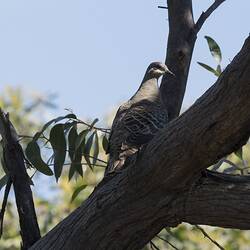General Description
A medium-sized, bulky pigeon. Has a distinct white line below the eye and a characteristic iridescent wing patch of blue, red and green metallic feathers with pale edges. Males have a slightly darker pinkish-grey breast and a yellow-white forehead. Body length of up to 36 cm. They look quite similar to Brush Bronzewings, Phaps elegans, which are a similar species but have a dark chestnut neck and back and a grey breast. Call a distinctive low frequency, repetitive "whoo-whoo-whoo".
Biology
Common Bronzewings are one of the most commonly observed pigeons in Australia. They are generally seen alone or in pairs, often close to a water source as they need to drink frequently. They are very wary and are easily startled. When flushed, their wings produce a loud clattering sound as they take off. Common Bronzewings feed on the ground in small groups eating seeds and vegetable matter. Nests are built in a low branch or bush, made from twigs and sticks. Both parents incubate and care for the chicks, feeding them a special milky substance produced from the parent's crop.
Distribution
Mainland Australia and Tasmania.
Habitat
Heaths, forests and woodlands.
More Information
-
Animal Type
-
Brief Id
A medium-sized pigeon with an iridescent wing patch.
-
Maximum Size
36 cm
-
Habitats
-
Diet
Herbivore
-
Diet Categories
Seeds, Plant matter
-
Endemicity
-
Commercial
No
-
Conservation Statuses
CITES: Not listed, FFG Threatened List: Not listed, EPBC Act 1999: Not listed, IUCN Red List: Least Concern
-
Taxon Name
-
Scientific Author
(Latham, 1790)
-
Common Name
Common Bronzewing
-
Kingdom
-
Phylum
-
Subphylum
-
Class
-
Subclass
-
Superorder
-
Order
-
Family
-
Subfamily
-
Genus
-
Species Name
chalcoptera









